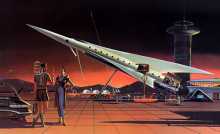Burress (who wrote that he figured the following math on notebook paper and spreadsheets, which seems to me like quantifying the stock-market with sea-shells) attempted to use current markers of space technology to extrapolate (conservatively) the necessities in reaching the closest extrasolar planet; a gas giant orbiting Epsilon Eridani about 10.4 light-years away.
Estimating the ship to be 2000 metric tons, which is roughly the mass of the Space Station (and far too small to actually make the trip, but adequate for our purposes),the mathematics will not take into account the weight of the fuel needed; which as you’ll see, would be substantial. Speaking of fuel, there would need to be enough to create the amount of thrust necessary to accelerate 2,000 tons at 1 gee (an amount of force equal to one of Earth’s atmospheres, about 10 meter per second per second) to achieve a high enough velocity to get to the destination. Burress estimates that 30,000 kilometers a second (about 1/10th the speed of light) will get us there in 103 or 104 years. In order to reach that velocity, we would need to accelerate at 1 gee for about 35 days. That’s about 20 billion tons of rocket fuel. 20 billion tons of fuel for one 2,000 ton spaceship, and that’s just to get there…
So obviously it would take substantial amounts of energy to propel even a too-small space craft to the nearest solar system. Burress does recommend, once it’s technologically viable, antimatter fuel (just like the Starship Enterprise!) At the moment we don’t have the technological capability of harnessing an antimatter reaction, but when we do it would take only 5 tons of antimatter (mixed with an equivalent amount of normal matter), to create the necessary energy to propel our little ship to Epsilon Eridani. Of course, once you get there you’re still just floating around a completely uninhabitable gas giant with nowhere to go. But hey, that’s interstellar travel.
